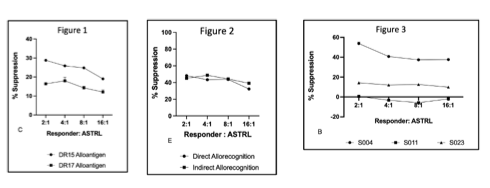Bystander Suppression: Enhancing the Power of Ex Vivo Expanded Antigen Specific Regulatory Cell Lines
1Renal, Brigham and Women's Hospital, Boston, MA, 2Nephrology, Clinica Universidad de Navarra, Ripagaina, Spain, 3Brigham and Women's Hospital, Boston, MA, 4Medicine, Brigham and Women's Hospital, Boston, MA
Meeting: 2022 American Transplant Congress
Abstract number: 1259
Keywords: Graft acceptance, HLA-DR allopeptides, Kidney transplantation, T cells
Topic: Basic Science » Basic Science » 10 - Treg/Other Regulatory Cell/Tolerance
Session Information
Session Name: Treg/Other Regulatory Cell/Tolerance
Session Type: Poster Abstract
Date: Monday, June 6, 2022
Session Time: 7:00pm-8:00pm
 Presentation Time: 7:00pm-8:00pm
Presentation Time: 7:00pm-8:00pm
Location: Hynes Halls C & D
*Purpose: The potential of T regulatory cell (Treg) based therapies in transplantation has been demonstrated in various preclinical models. Multiple clinical trials are currently undergoing to successfully transition Treg based cell therapies to the clinic. We have successfully expanded Antigen-Specific T regulatory cell enriched Lines (ASTRL) ex vivo and demonstrated their efficacy in a rat model of kidney transplant. ASTRLs expanded from stable kidney transplant recipients (KTRs) express multiple conventional regulatory markers and suppress antigen specific T cell responses. The suppressive effect of ASTRLs is mediated primarily through the CD39/CD73 pathway. ASTRLs secrete immunoregulatory extracellular vesicles enriched with proteins associated with cognate TCR recognition. The present work was designed to understand whether ASTRLs confer indirect allospecificity via bystander suppression.
*Methods: ASTRLs were expanded from peripheral blood mononuclear cells of stable KTRs by multiple stimulations in presence of a single donor antigen and low dose IL-2 and harvested between day 30-35. The suppressive ability of the ASTRLs were determined using a standard suppression assay.
*Results: Our data show that ASTRLs successfully inhibit T effector response to multiple donor antigens via bystander suppression. ASTRL expanded in presence of a single donor antigen (DR15) was successfully able to suppress T cell proliferation against the same antigen (DR15) as well as a different donor antigen (DR17), and vice versa (Fig 1). Effector response to donor derived cells via direct allorecognition was also suppressed by ASTRLs (Fig 2). These data show the ability of ASTRLs to confer indirect allospecificity to multiple donor antigens. Figure 3 shows ASTRL expanded against donor derived DR4 in one recipient (S004) did not suppress the effector response in other recipients (S011, S023) also mismatched to DR4 with their donors, indicating an autologous and individualized effect. However, ASTRLs did not suppress effector response to nonspecific CD3/CD28 stimulation.
*Conclusions: ASTRLs exert both antigen specific and bystander suppression demonstrating superior suppressive ability and immunoregulatory potential without interfering with the global immune response; characteristics vital for successful therapeutic translation to clinic.
To cite this abstract in AMA style:
Tripathi S, Martin-Moreno PL, Kavalam GJ, Schreiber B, Wagaa-Gasser A, Chandraker A. Bystander Suppression: Enhancing the Power of Ex Vivo Expanded Antigen Specific Regulatory Cell Lines [abstract]. Am J Transplant. 2022; 22 (suppl 3). https://atcmeetingabstracts.com/abstract/bystander-suppression-enhancing-the-power-of-ex-vivo-expanded-antigen-specific-regulatory-cell-lines/. Accessed December 21, 2025.« Back to 2022 American Transplant Congress

